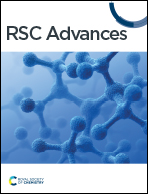De novo designed aliphatic and aromatic peptides assemble into amyloid-like cytotoxic supramolecular nanofibrils†
Abstract
Peptides are very interesting biomolecules that upon self-association form a variety of thermodynamically stable supramolecular structures of nanometric dimension e.g. nanotubes, nanorods, nanovesicles, nanofibrils, nanowires and many others. Herein, we report six peptide molecules having a general chemical structure, H-Gaba-X-X-OH (Gaba: γ-aminobutyric acid, X: amino acid). Out of these six peptides, three are aromatic and the others are aliphatic. Atomic force microscopic (AFM) studies reveal that except peptide 6 (H-Gaba-Trp-Trp-OH), all the reported peptides adopt nanofibrillar morphology upon aggregation in aqueous medium. These supramolecular assemblies can recognize amyloid-specific molecular probe congo red (CR) and thioflavine t (ThT) and exhibit all the characteristic properties of amyloids. The MTT cell viability assay reveals that the toxicity of both aliphatic and aromatic peptides increases with increasing concentration of the peptides to both cancer (HeLa) and non-cancer (HEK 293) cells. Of note, the aromatic peptides show a slightly higher cytotoxic effect compared to the aliphatic peptides. Overall, the studies highlight the self-assembling nature of the de novo designed aliphatic and aromatic peptides and pave the way towards elucidating the intricacies of pathogenic amyloid assemblies.



 Please wait while we load your content...
Please wait while we load your content...